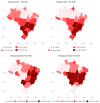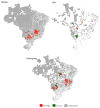Rising Incidence and Spatiotemporal Dynamics of Emerging and Reemerging Arboviruses in Brazil
- PMID: 40006913
- PMCID: PMC11860164
- DOI: 10.3390/v17020158
Rising Incidence and Spatiotemporal Dynamics of Emerging and Reemerging Arboviruses in Brazil
Abstract
Background: Brazil has witnessed the co-circulation of dengue virus (DENV), Zika virus (ZIKV), and chikungunya virus (CHIKV), with outbreaks exacerbated by environmental factors, social determinants, and poor sanitation. The recent re-emergence of Oropouche virus (OROV) has added complexity to vector control strategies, emphasizing the need for integrated approaches to curb arboviruses spread. We aimed to analyze temporal trends and spatial distributions with national scope of these emerging arboviruses.
Methods: An ecological study using data from the Brazilian Notifiable Diseases Information System the period from 2023 to 2024 was undertaken. Temporal trends were evaluated using Joinpoint regression, while spatial analysis was conducted using Moran's I, and local indicators of spatial association.
Results: Dengue fever cases increased by 322%, while Oropouche fever (OF) increased by 300%. The states of Amazonas and Espírito Santo reported increases in OF cases. Moran's I test revealed spatial clustering of DENV and CHIKV. Two municipalities in the state of Mato Grosso do Sul showed cocirculation of DENV, CHIKV, and ZIKV.
Conclusions: This study identified a surge in arbovirus cases between 2023 and 2024, with peak incidences from January to March and October to December, linked to favorable climatic conditions. Clustering patterns and co-circulation of arboviruses highlight the need for tailored control and prevention strategies and targeted interventions to mitigate their impact.
Keywords: Oropouche virus; Zika virus; chikungunya virus; dengue; emergent pathogen.
Conflict of interest statement
The authors declare no conflicts of interest.
Figures




Similar articles
-
Retrospective Study of Arbovirus Circulation in Northeast Brazil in 2019 and 2022: Insights into the Re-Emergence of DENV-3 and the Co-Infection of DENV-1 and CHIKV.Viruses. 2025 Mar 26;17(4):475. doi: 10.3390/v17040475. Viruses. 2025. PMID: 40284918 Free PMC article.
-
Assessment of a multiplex arbovirus PCR Detection Test in an area endemic for Chikungunya, Zika, and Dengue viruses: An evaluation of kit performance characteristics in line with Clinical Laboratory Improvement Amendments (CLIA) Standards.PLoS One. 2025 Jun 24;20(6):e0309626. doi: 10.1371/journal.pone.0309626. eCollection 2025. PLoS One. 2025. PMID: 40554518 Free PMC article.
-
Detecting Arboviruses Through Screening Asymptomatic Blood Donors in Rio de Janeiro/Brazil During a Dengue Outbreak.Viruses. 2025 Feb 5;17(2):224. doi: 10.3390/v17020224. Viruses. 2025. PMID: 40006979 Free PMC article.
-
Prevalence of Chikungunya, Dengue and Zika viruses in blood donors: a systematic literature review and meta-analysis.Blood Transfus. 2022 Jul;20(4):267-280. doi: 10.2450/2021.0106-21. Epub 2021 Sep 22. Blood Transfus. 2022. PMID: 34694219 Free PMC article.
-
Heart Disease and Arboviruses: A Systematic Review and Meta-Analysis.Viruses. 2022 Sep 8;14(9):1988. doi: 10.3390/v14091988. Viruses. 2022. PMID: 36146794 Free PMC article.
References
-
- Zardini A., Menegale F., Gobbi A., Manica M., Guzzetta G., d’Andrea V., Marziano V., Trentini F., Montarsi F., Caputo B., et al. Estimating the Potential Risk of Transmission of Arboviruses in the Americas and Europe: A Modelling Study. Lancet Planet. Health. 2024;8:e30–e40. doi: 10.1016/S2542-5196(23)00252-8. - DOI - PubMed
-
- Carvalho F.R., Medeiros T., Vianna R.A.d.O., Douglass-Jaimes G., Nunes P.C.G., Quintans M.D.S., Souza C.F., Cavalcanti S.M.B., Dos Santos F.B., de Oliveira S.A., et al. Simultaneous Circulation of Arboviruses and Other Congenital Infections in Pregnant Women in Rio de Janeiro, Brazil. Acta Trop. 2019;192:49–54. doi: 10.1016/j.actatropica.2019.01.020. - DOI - PubMed
-
- Scachetti G.C., Forato J., Claro I.M., Hua X., Salgado B.B., Vieira A., Simeoni C.L., Barbosa A.R.C., Rosa I.L., de Souza G.F., et al. Re-Emergence of Oropouche Virus between 2023 and 2024 in Brazil: An Observational Epidemiological Study. Lancet Infect. Dis. 2024. online ahead of print . - DOI - PMC - PubMed
MeSH terms
LinkOut - more resources
Full Text Sources
Research Materials

